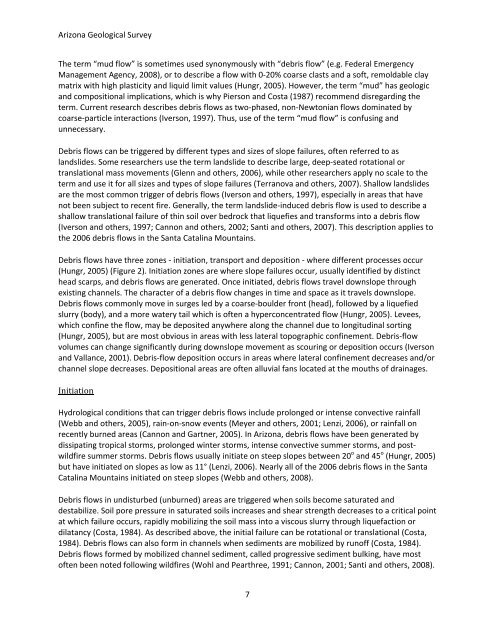Arizona Geological Survey OPEN-FILE REPORT OFR 08-06
Arizona Geological Survey OPEN-FILE REPORT OFR 08-06
Arizona Geological Survey OPEN-FILE REPORT OFR 08-06
Create successful ePaper yourself
Turn your PDF publications into a flip-book with our unique Google optimized e-Paper software.
<strong>Arizona</strong> <strong>Geological</strong> <strong>Survey</strong><br />
The term “mud flow” is sometimes used synonymously with “debris flow” (e.g. Federal Emergency<br />
Management Agency, 20<strong>08</strong>), or to describe a flow with 0‐20% coarse clasts and a soft, remoldable clay<br />
matrix with high plasticity and liquid limit values (Hungr, 2005). However, the term “mud” has geologic<br />
and compositional implications, which is why Pierson and Costa (1987) recommend disregarding the<br />
term. Current research describes debris flows as two‐phased, non‐Newtonian flows dominated by<br />
coarse‐particle interactions (Iverson, 1997). Thus, use of the term “mud flow” is confusing and<br />
unnecessary.<br />
Debris flows can be triggered by different types and sizes of slope failures, often referred to as<br />
landslides. Some researchers use the term landslide to describe large, deep‐seated rotational or<br />
translational mass movements (Glenn and others, 20<strong>06</strong>), while other researchers apply no scale to the<br />
term and use it for all sizes and types of slope failures (Terranova and others, 2007). Shallow landslides<br />
are the most common trigger of debris flows (Iverson and others, 1997), especially in areas that have<br />
not been subject to recent fire. Generally, the term landslide‐induced debris flow is used to describe a<br />
shallow translational failure of thin soil over bedrock that liquefies and transforms into a debris flow<br />
(Iverson and others, 1997; Cannon and others, 2002; Santi and others, 2007). This description applies to<br />
the 20<strong>06</strong> debris flows in the Santa Catalina Mountains.<br />
Debris flows have three zones ‐ initiation, transport and deposition ‐ where different processes occur<br />
(Hungr, 2005) (Figure 2). Initiation zones are where slope failures occur, usually identified by distinct<br />
head scarps, and debris flows are generated. Once initiated, debris flows travel downslope through<br />
existing channels. The character of a debris flow changes in time and space as it travels downslope.<br />
Debris flows commonly move in surges led by a coarse‐boulder front (head), followed by a liquefied<br />
slurry (body), and a more watery tail which is often a hyperconcentrated flow (Hungr, 2005). Levees,<br />
which confine the flow, may be deposited anywhere along the channel due to longitudinal sorting<br />
(Hungr, 2005), but are most obvious in areas with less lateral topographic confinement. Debris‐flow<br />
volumes can change significantly during downslope movement as scouring or deposition occurs (Iverson<br />
and Vallance, 2001). Debris‐flow deposition occurs in areas where lateral confinement decreases and/or<br />
channel slope decreases. Depositional areas are often alluvial fans located at the mouths of drainages.<br />
Initiation<br />
Hydrological conditions that can trigger debris flows include prolonged or intense convective rainfall<br />
(Webb and others, 2005), rain‐on‐snow events (Meyer and others, 2001; Lenzi, 20<strong>06</strong>), or rainfall on<br />
recently burned areas (Cannon and Gartner, 2005). In <strong>Arizona</strong>, debris flows have been generated by<br />
dissipating tropical storms, prolonged winter storms, intense convective summer storms, and postwildfire<br />
summer storms. Debris flows usually initiate on steep slopes between 20 o and 45 o (Hungr, 2005)<br />
but have initiated on slopes as low as 11° (Lenzi, 20<strong>06</strong>). Nearly all of the 20<strong>06</strong> debris flows in the Santa<br />
Catalina Mountains initiated on steep slopes (Webb and others, 20<strong>08</strong>).<br />
Debris flows in undisturbed (unburned) areas are triggered when soils become saturated and<br />
destabilize. Soil pore pressure in saturated soils increases and shear strength decreases to a critical point<br />
at which failure occurs, rapidly mobilizing the soil mass into a viscous slurry through liquefaction or<br />
dilatancy (Costa, 1984). As described above, the initial failure can be rotational or translational (Costa,<br />
1984). Debris flows can also form in channels when sediments are mobilized by runoff (Costa, 1984).<br />
Debris flows formed by mobilized channel sediment, called progressive sediment bulking, have most<br />
often been noted following wildfires (Wohl and Pearthree, 1991; Cannon, 2001; Santi and others, 20<strong>08</strong>).<br />
7
















